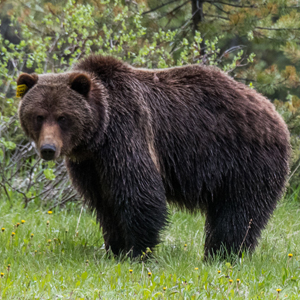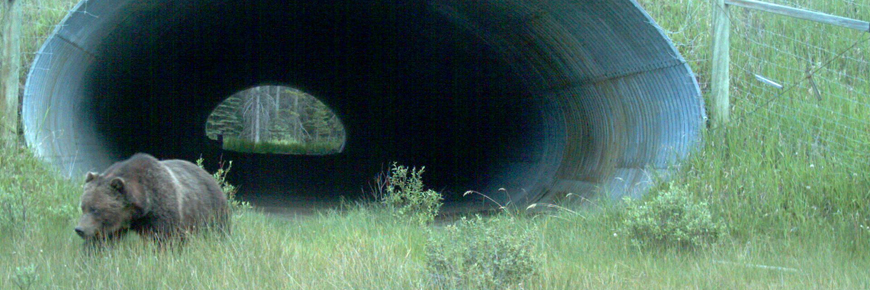
Grizzly bear
Yoho National Park
Quick facts
Weigh up to 300 kg (Canadian Rocky Mountain populations)
Eats mostly plants, 15% of diet is meat
Lifespan of 20-30 years
Status: Special concern (COSEWIC)

Grizzly bears have one of the lowest known reproductive rates of all North American land mammals. The rate is even lower for grizzlies living here in the Canadian Rockies. Females have their first cubs at 5-8 years of age and may not become pregnant again for 4-5 years.
Cubs learn a lot during the three or more years they spend with their mom. She shows them the best places to dig roots in spring, feast on berries in summer and flip rocks to find insects and their larvae in fall. They learn to search for winter-killed wildlife, newborn elk calves, and hibernating ground squirrels.
She may cover a 200-500 km2 area wandering in search for food. Adult males cover even more ground – up to 2000 km2. After six months or so, food becomes scarce and the bears crawl into their dens to sleep the winter.
It takes a big land base to support a self-sustaining population of grizzly bears. Even the combined area of Banff, Jasper, Yoho and Kootenay national parks does not provide enough habitat on its own.
Where to see
Look for grizzly bears feeding on dandelions in spring and early summer along park highways. Best viewing times for most park wildlife is dawn and dusk. Never approach or feed a bear.
Why is the grizzly bear in danger?
Grizzly bears are at risk for the following reasons:
- towns, roads, and other land uses are breaking their habitat into increasingly small pieces
- every year bears are killed on roads and railways
- grizzly bear populations take a long time to recover due to their low reproductive rate
What are we doing to help this species?

Yoho National Park is helping to maintain grizzly bear populations by:
- working with provincial partners to maintain grizzly bear populations in the broader Rocky Mountain landscape
- monitoring bear activity in the park using remote wildlife cameras and sightings
- installing fencing, overpasses and underpasses to allow them to cross highways safely
- finding ways to keep grizzly bears safe along railways
- reducing bear attractants
- educating park visitors about how to keep themselves and bears safe
Learn more
Species at Risk Public Registry – Species profile: Grizzly bear, Western population- Date modified :